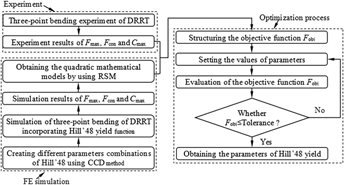Published online by Cambridge University Press: 21 March 2017

Hill’48 yield function has been widely used to describe the anisotropic behaviors of material in FE simulation of tube and sheet metal forming process. To obtain the material behaviors of small-sized H96 brass extrusion double-ridged rectangular tube (DRRT) in bending process, an inverse method combining response surface method and three-point bending was proposed to identify the parameters of Hill’48 yield function. It was found that comparing with Hill’48 yield function only considering the normal anisotropy and Mises yield function, Hill’48 yield function with the identified parameters performs the best in reproducing the material behavior of H96 brass DRRT in three-point bending process. And then Hill’48 yield function with the identified parameters was also adopted in the FE simulations of rotary draw bending of DRRT. It was observed that the prediction accuracy of cross sectional deformation of DRRT in rotary bending process was improved effectively by using Hill’48 yield function with the identified parameters. This proves that the proposed inverse method is suitable to the real forming process.
Contributing Editor: Jürgen Eckert